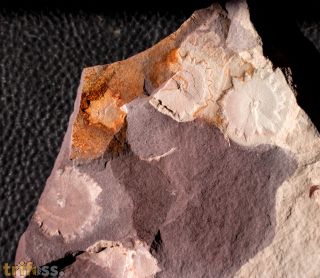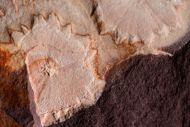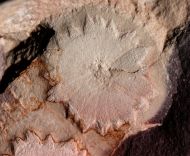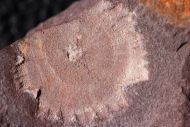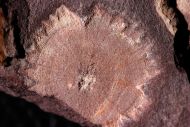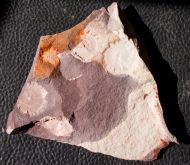Fossils for sale
Welcome back!
Sold:
?Liaonanella planodisciformis Hong et al., 1988
Products description
| This is a cluster of medusoid fossils from the Ediacaran Ranford Formation of West Australia. The Largest specimen on this plate measures about 18 mm in diameter. The discoidal fossils are attributed to the "medusa-like" genus Liaonanella (Hong et al., 1988). Their interpretation has since been the subject of controversial discussions in the scientific literature. Non-biogenic origins, such as those discussed for the finds from the Ranford Formation, have also been considered. The fossils were described as being taxonomically fundamentally different from the Ediacaran fauna. Zhang et al. (2006) examined specimens from the Chinese Jinxian Biota but did not compare them with the Ediacaran fauna or other Precambrian organisms. However, they confirmed the classification by Hong et al. (1986) and described flat, circular, or elliptical fossils with a marginal rim and concentric or spiral patterns, preserved as thin membranes replaced by quartz and chlorite. Moczydłowska and Meng (2016) referred to these finds from the Jinxian Biota as "Aspidella-like" and discussed the possibility that Liaonanella could belong to the same morphological group as Aspidella. However, the exact relationship remains unclear. Liaonanella is not directly considered a synonym of Aspidella, but the study suggests some similarities in morphology. Luo et al. (2016) demonstrated that larger, more complex organisms appeared as early as the Cryogenian. At least for the finds from the Jinxian Biota, the biogenic nature of the discoidal structures is not in question. These structures were transported by micro-turbidites (suspension clouds of fine-grained sediments) and quickly buried, leading to apparently different preservation forms due to embedding processes. The finds from the Australian Ranford Formation are often referred to as "Porpita Liaonanella" because they bear similarities to Porpita porpita (Linnaeus, 1758). The fossils exhibit certain features that could be associated with hydrozoans, such as radial symmetries. However, this is a speculative interpretation. The finds from Kununurra are attributed to the early Ediacaran and are probably best addressed as ?Liaonanella planodisciformis. Hong, Z., Z. Huang, X. Yang, J. Lan, B. Xian, and Y. Yang. (1988). Medusoid fossils from the Sinian Xingmincun Formation of southern Liaoning. Acta Geologica Sinica 62(3): 200–209 Luo, Cui, Maoyan Zhu, and Joachim Reitner. (2016) "The Jinxian Biota revisited: taphonomy and body plan of the Neoproterozoic discoid fossils from the southern Liaodong Peninsula, North China." Paläontologische Zeitschrift 90, no. 2: 205-224. https://doi.org/10.1007/s12542-016-0289-5. Moczydłowska, M. & Meng, F. (2016): The Ediacaran Aspidella-type impressions in the Jinxian successions of Liaoning Province, northeastern China. Lethaia, Vol. 49, pp. 617–630. Zhang, Xingliang & Hua, Hong & Reitner, Joachim. (2006). A new type of Precambrian megascopic fossils: The Jinxian biota from northeastern China. Facies. 52. 169-181. 10.1007/s10347-005-0027-z. | |||
Location: | Kununarra, Western Australia | ||
| Plate Size : | about 73 x 71 mm | ||
| Age: | Ediacaran, Johnny Cake Shale Member, Randford formation (about 670Ma) | ||
Product no.: 11663
